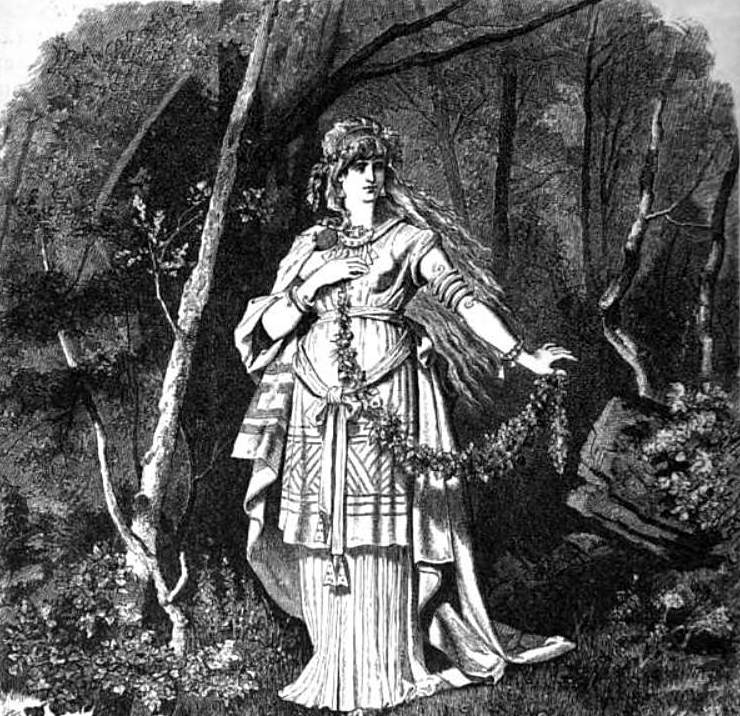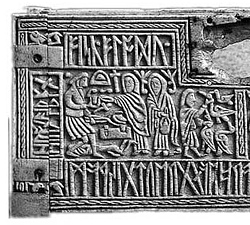|
Neorxnawang
Neorxnawang (also Neorxenawang and Neorxnawong) is an Old English noun used to translate the Christian concept of paradise in Anglo-Saxon literature.Simek (2007:229). Scholars propose that the noun originally derives from Germanic mythology, referring to a "heavenly meadow" or place without toil or worries.Jeep (2001:554). Etymology While the second half of the word, -''wang'', is widely acknowledged to mean 'field' (and its cognate ''waggs'' appears for 'paradise' in Gothic), scholars have yet to reach an agreement regarding the first element's meaning – though at least a dozen attempts to interpret it have been made. Scholar Rudolf Simek states that it is possible to consider the term as a Proto-Germanic term for 'Asgard' or 'Other World' due to the noun's unclear meaning, that Christian authors who used it seemed to have a poor understanding of it as well, and that it corresponds with the North Germanic terms ''Iðavöllr'' (possibly 'field of activity' or 'the continuall ... [...More Info...] [...Related Items...] OR: [Wikipedia] [Google] [Baidu] |
Fólkvangr
In Norse mythology, Fólkvangr (Old Norse "field of the host"Orchard (1997:45). or "people-field" or "army-field"Lindow (2001:118).) is a meadow or Field (agriculture), field ruled over by the goddess Freyja where half of those that die in combat go upon death, whilst the other half go to the god Odin in Valhalla. Others were also brought to Fólkvangr after their death; ''Egils Saga'', for example, has a world-weary female character declare that she will never taste food again until she dines with Freyja. Fólkvangr is attested in the ''Poetic Edda'', compiled in the 13th century from earlier traditional sources, and the ''Prose Edda'', written in the 13th century by Snorri Sturluson. According to the ''Prose Edda'', within Fólkvangr is Freyja's hall Sessrúmnir. Scholarly theories have been proposed about the implications of the location. Attestations In the poem ''Grímnismál'' collected in the ''Poetic Edda'', Odin (disguised, or ''List of names of Odin, Grímnir'') tells t ... [...More Info...] [...Related Items...] OR: [Wikipedia] [Google] [Baidu] |
Old English
Old English ( or , or ), or Anglo-Saxon, is the earliest recorded form of the English language, spoken in England and southern and eastern Scotland in the Early Middle Ages. It developed from the languages brought to Great Britain by Anglo-Saxon settlers in the mid-5th century, and the first Old English literature dates from the mid-7th century. After the Norman Conquest of 1066, English was replaced for several centuries by Anglo-Norman language, Anglo-Norman (a langues d'oïl, type of French) as the language of the upper classes. This is regarded as marking the end of the Old English era, since during the subsequent period the English language was heavily influenced by Anglo-Norman, developing into what is now known as Middle English in England and Early Scots in Scotland. Old English developed from a set of Anglo-Frisian or Ingvaeonic dialects originally spoken by Germanic tribes traditionally known as the Angles (tribe), Angles, Saxons and Jutes. As the Germanic settlers ... [...More Info...] [...Related Items...] OR: [Wikipedia] [Google] [Baidu] |
Anglo-Saxon Runes
Anglo-Saxon runes or Anglo-Frisian runes are runes that were used by the Anglo-Saxons and Medieval Frisians (collectively called Anglo-Frisians) as an alphabet in their native writing system, recording both Old English and Old Frisian (, ᚱᚢᚾᚪ, "rune"). Today, the characters are known collectively as the futhorc (ᚠᚢᚦᚩᚱᚳ, ''fuþorc'') from the sound values of the first six runes. The futhorc was a development from the older Germanic peoples, co-Germanic 24-character runic alphabet, known today as Elder Futhark, expanding to 28 characters in its older form and up to 34 characters in its younger form. In contemporary Scandinavia, the Elder Futhark developed into a shorter 16-character alphabet, today simply called Younger Futhark. Use of the Anglo-Frisian runes is likely to have started in the 5th century onward and they continued to see use into the High Middle Ages. They were later accompanied and eventually overtaken by the Old English Latin alphabet introdu ... [...More Info...] [...Related Items...] OR: [Wikipedia] [Google] [Baidu] |
University Of Helsinki
The University of Helsinki (, ; UH) is a public university in Helsinki, Finland. The university was founded in Turku in 1640 as the Royal Academy of Åbo under the Swedish Empire, and moved to Helsinki in 1828 under the sponsorship of Alexander I of Russia, Tsar Alexander I. The University of Helsinki is the oldest and largest university in Finland with a range of disciplines available. In 2022, around 31,000 students were enrolled in the degree programs of the university spread across 11 faculties and 11 research institutes. As of 1 August 2005, the university complies with the harmonized structure of the Europe-wide Bologna Process and offers bachelor, master, licenciate, and Doctorate, doctoral degrees. Admission to degree programmes is usually determined by entrance examinations, in the case of bachelor's degrees, and by prior degree results, in the case of master and postgraduate degrees. The university is bilingual, with teaching by law provided both in Finnish and Swedi ... [...More Info...] [...Related Items...] OR: [Wikipedia] [Google] [Baidu] |
RMN Newsletter
''RMN Newsletter'' is a peer-reviewed and open access academic journal published on a bi-annual basis by the University of Helsinki’s Department of Folklore Studies. Published in both digital and print editions, ''RMN Newsletter'' covers topics relevant to folkloristics, linguistics, history, archaeology, and philology, especially in the areas of Germanic studies, Finno-Ugric studies, and Baltic studies. The publication places particular emphasis on what the journal refers to as "retrospective methods", a research method that compares material recorded in differing periods.See for example Heide, Eldar. 2010. "Why a Network for Retrospective Methods?". ''RMN Newsletter'', 1, pp. 6-7. University of Helsinki. Online/ref> Since its inception in December 2010, the journal has been edited by Frog, a University of Helsinki docent The term "docent" is derived from the Latin word , which is the third-person plural present active indicative of ('to teach, to lecture'). Becoming a d ... [...More Info...] [...Related Items...] OR: [Wikipedia] [Google] [Baidu] |
Translated From The Fourth Edition With Notes And Appendix
Translation is the communication of the meaning of a source-language text by means of an equivalent target-language text. The English language draws a terminological distinction (which does not exist in every language) between ''translating'' (a written text) and ''interpreting'' (oral or signed communication between users of different languages); under this distinction, translation can begin only after the appearance of writing within a language community. A translator always risks inadvertently introducing source-language words, grammar, or syntax into the target-language rendering. On the other hand, such "spill-overs" have sometimes imported useful source-language calques and loanwords that have enriched target languages. Translators, including early translators of sacred texts, have helped shape the very languages into which they have translated. Because of the laboriousness of the translation process, since the 1940s efforts have been made, with varying degrees o ... [...More Info...] [...Related Items...] OR: [Wikipedia] [Google] [Baidu] |




